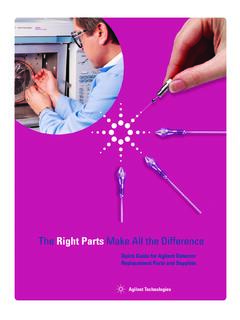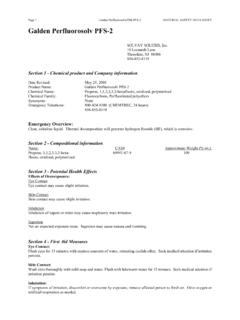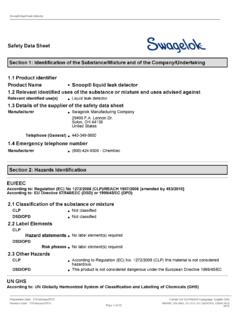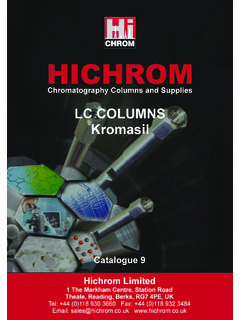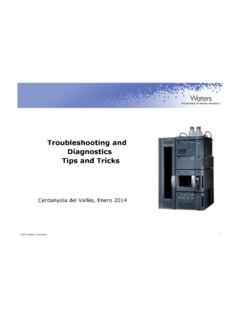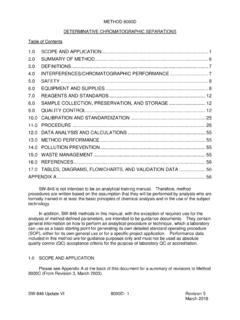Transcription of GC System Recommended Maintenance Schedule
1 GC System Recommended Gas ManagementITEMTYPICAL SCHEDULEACTIONS/COMMENTSGas purifiersEvery 6 to12 months Replacement Schedule is based on capacity and grade of gases. (carrier gas andIn general, replace non-indicating traps every 6 to 12 months or when detector gas)indicating traps start to change color. Replace indicating traps when indicating material is vent trapEvery 6 months* Every 1 to 2 years Re-calibrate electronic flowmeters follow Recommended Schedule forcalibrationthe unit (shown on the calibration certificate).Sample Introduction and InletsITEMTYPICAL SCHEDULEACTIONS/COMMENTSS yringes Every 3 months* Replace syringe if dirt is noticeable in the syringe, if it cannot beand/or syringecleaned, if the plunger doesn t slide easily, or if clogged. Replace needlesneedle if septa wear is abnormal or the needle becomes linerWeekly*Check often.
2 Replace when dirt is visible in the liner or if chromatography is O-ringsMonthly*Replace with liner or with signs of septumDaily*Check often. Replace when signs of deterioration are visible (gaping holes, fragments in inlet liner, poor chromatography, low column pressure, etc.).Inlet hardwareEvery 6 months Check for leaks and yearCheck parts and replace when parts are worn, scratched or broken. Inlet gold or stainless Monthly*Check for scratches, corrosion, or build-up of non-volatile sample components and steel seal replace if SCHEDULEACTIONS/COMMENTSF ront-end Weekly monthly* Remove 1 2to 1 meter from the front of the column when experiencing maintenancechromatographic problems (peak tailing, decreased sensitivity, retention time changes, etc.). Replace inlet liner, septum and clean inlet as necessary.
3 Guard column may be useful for increasing column rinseAs neededPerform when chromatography degradation is due to column contamination. Only for bonded and cross-linked neededReplace when trimming and/or solvent rinsing no longer return chromatographic As neededReplace when changing columns and inlet/detector SCHEDULEACTIONS/COMMENTSFID/NPD jets As needed Clean when deposits are present. Replace when they become scratched, and collectorbent or damaged, or when having difficulty lighting FID or keeping flame beadAs neededReplace when signal drifts or there is a dramatic change in Every 6 monthsMeasure hydrogen, air and makeup gas neededThermally clean by baking-out when a wandering baseline, increased noise, or a change in response is present. Replace when thermal cleaning does not resolve the 6 months Wipe neededThermally clean by baking-out when baseline is noisy, or the output value is abnormally high.
4 Replace when thermal cleaning does not resolve the 6 monthsMeasure hydrogen, air and makeup gas neededClean/replace FPD windows and seals when detector sensitivity is Selective DetectorsACTIONTYPICAL SCHEDULECOMMENTSTune MSDAs neededKeep plenty of PFTBA (part number 05971-60571) on hand .Check the calibration vialEvery 6 monthsVial can be refilled without venting the the foreline Every 6 monthsCheck the fluid weekly. Change when the fluid becomes discolored or pump oilevery 6 the diffusion Every year orCheck the fluid weekly. Too little fluid will cause the pump to run at a pump fluidas neededhigher temperature, resulting in degradation and loss of high vacuum. Change when the fluid is discolored or contains the ion sourceAs neededClean when performance deteriorates to remove contamination and restore the electrostatic properties of the ion lensing System .
5 Replace scratched parts to maintain optimal , the downtime for scheduled Maintenance is always less disruptive than the downtime for unscheduledmaintenance and troubleshooting!* Schedule is an approximation of average usage requirements. Frequency may vary widely based upon application and sample column or detector performance oftenwith column or instrument check-out stan-dards. See the Agilent catalog for the full lineof detector and column evaluation Guide for Agilent GCSystem MaintenanceGC Maintenance ScheduleThis information is subject to change without notice. Agilent Technologies, Inc. 2002 Printed in USA May 15, more information:For detailed information about GC suppliesfrom Agilent, please contact your local Agilentsales representative, or your authorized distributor, or visit us on-line.
6 Ask aboutAgilent s other valuable Maintenance Guidesfor GC, GC/MS, and LC: Maintaining Your GC/MS System (publication 5988-3960) GC Inlet Resource Guide (publication 5988-3466) Maintaining Your HPLC System (publication 5988-4269)


